Melbourne, Venice and the shop window
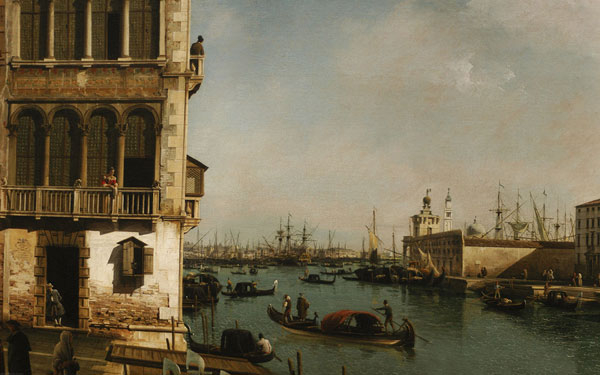
The first thing you might notice about the Melbourne General Post Office is that it is no longer a post office. It has been adapted by my firm, Williams Boag Architects, to create an historic and aesthetically pleasing, upscale shopping centre. The former postal hall was an ideal vessel for the creation of large retail space, and the delicate glass boxes that intrude into the room do not distract from its primary shape and volume.
One thing that I have noticed about the GPO, as it is called, is that it is not similar to the buildings framing Piazza San Marco in Venice in many respects, and yet there is a thread of something linking the two. The impression is fleeting, and primarily a consequence of the arched colonnade that extends along Elizabeth Street, wrapping around the southern end of the building alongside Bourke Street. There is a cafe under the colonnade, and when I have the time I like to sit beneath the arches on the little padded benches provided, pretending that I am in a far older city with a far greater appeal to the imagination than Melbourne can currently provide.
Don’t misunderstand me: I am not entirely dismissive of Melbourne's charms, and its history is both convoluted and fascinating, not without its share of chiaroscuro and drama. The night the GPO burnt down in 2000 was one such moment. Nevertheless I find myself acutely aware that Melbourne is not Venice, nor Florence, nor Rome; also, I am defiantly unwilling to abandon the wish that Melbourne was like these places in some ways, despite the Euro-centric view being so unfashionable right now.
Melbourne is not an Asian city in urban terms: it is patterned on a western new-world model, and defined in its bones by western architecture. While the current building frenzy carries a whisper of the east, the critical mass and sheer volume of activity is not there, and the patterns of the City are still primarily European.
As a city with mixed cultural and social, but strongly European physical history, I have a strong desire for this City to be more than it is. Not more than it was, perhaps, but more than it is now. Venice's greatest quality is that despite the glare and noise of relentless tourist inundation, it still maintains its shadows. La Serenissima endured for nearly a thousand years and its carapace is still with us; across such a time things begin to build up, and time and gravity conspire to settle the dust and darkness that would otherwise be kicked up by the garish process of destruction and renewal you see in less mature cities. Less mature cities like Melbourne, for example.
I once spoke to a Dutch man who had moved to Melbourne as an adult, and he didn't understand the constant destruction of buildings and their replacement with new buildings of approximately the same purpose, which are then stripped out in a decade or less to begin the process again. He didn't understand this passion for building and novelty, and having stayed in Amsterdam I can understand his point of view.
Little of what is built here has time to endure, but of course in some ways this is not such a bad thing. The thought that future generations might have to live with much of what we are constructing now inspires sadness and horror in equal measure. Fortunately there is a disposability to much contemporary construction, which is either hollow at its core or made flimsy in its superficial finish or appendages. It is fashionable to embrace this, to work with the depthless surface and celebrate life lived millimetres deep, rather than to see it as a deficit. Unfortunately enough for me, I have returned to the point where once again I perceive a building that is 'all surface' to be merely superficial: inessential and of little enduring consequence or substance.
This surface quality is not to be confused with lightness, a different beast altogether, and one that can be imparted to a block of marble by a skilled enough artisan. I know a man who carved a block of marble to appear as if it had a silk sheet draped over it. Interestingly enough, he carved the sculpture in residence in Rome. This kind of lightness, one of Calvino's six memos for the new millennium, is all about weight - the absence, the defiance of or the proximity to a great weight. Something is joyously light as a counterpoint to its alternative, which is the crushing weight of death. Everything built of lightness has weight in its shadows.
Of all the Australian designers working today, Amanda Henderson of Gloss Creative is one of a very small group who intuitively understands this, and her work is exciting to me. Gloss Creative works in the medium of lightness and not superficiality, designing things as ephemeral as 'brand experiences', which is a jargonistic way of saying three-dimensional shop displays and spaces for events. Catwalks, Race Day marquees and shop displays are all regular gigs.
On first consideration these kinds of projects would appear to be the very quintessence of the superficial, the epitome of what I decry above. In fact, a curious inversion occurs where the temporary nature of each Gloss project liberates the work from the responsibility of carrying social or cultural weight for any but the shortest length of time. It lives for its alotted time, and the time expires. At the end of that period, during which the work stands up more than well, up to 95% of the physical substance is recycled into new projects or uses, and the work is left as but a shared memory.
It comes, you see it, it conquers, and then it's gone.
Many architects are designing buildings as if they were 'brand experiences', and denying the fact that a building is a building and part of the city, not a prop or foile for an experience. My argument is simple: many 'leading' architects seem to be trying to pull off the kind of show-stopping brilliance that Henderson can pack into a single window display in a seemingly effortless fashion, but as their medium is architecture the desire is misplaced. The results are heavy, witless and laboured as examples of visual merchandising, and superficial and disposable as examples of architecture. In short, the worst of both worlds.
If our city is constantly rebuilding and never maturing, the deep shadows that make life so fascinating in the world's greatest cities may never find a place to settle here. We will be the poorer for it, but at least, thanks to Amanda Henderson and her team, the shop windows will be worth the visit.
A section through the writing cabinet
This section is not inspiring me yet. In fact it shows the writing cabinet to be little more than a dumb box with a low door into it. This is the point where a design idea founders or jumps the hurdle into the next interesting level. Nevertheless I don't think that this particular idea can evolve as much on paper as it will when I have the actual materials to hand, and start making all those micro-decisions, as a response to the qualities of the old doors and other elements. Where to cut, where to join, where to paint, where to stain.


A sketch: The Writing Cabinet against a window
This is a sketch of a so-called 'St Jerome', or writing cabinet, drawn positioned in a corner of my living room. It would take on the appearance of a timber box in the corner, with a single narrow door. Access and egress will be easy enough but not convenient, which is part of the point. I am thinking of constructing the box out of old solid core doors, and I have already sourced a supplier who deals in architectural recovery. The doors will not be very expensive, perhaps about $90 each, and they will possess a ready-made patina, which is somehow important to get the 'wood panelled' appearance I am seeking. I think I will need about six doors, and I will take a circular saw to them and reassemble them as a jigsaw puzzle with the joints expressed by narrow elements of new plywood.
You can see that the little writing desk will create a perch sitting just up against the window, which will afford me a clear view of the city ebbing and flowing past my window, about eight metres below me. The floor of the writing cabinet will be raised approximately 600mm above my living room floor, and as such the glass of the window will continue down below the writing surface, finishing about my knees somewhere. The high position of the chair in relation to the window sill should give the feeling that I am perched above the street, in a superior position for surveillance. This is essential for 'dipping out' of the headspace of writing.

You can see that the little writing desk will create a perch sitting just up against the window, which will afford me a clear view of the city ebbing and flowing past my window, about eight metres below me. The floor of the writing cabinet will be raised approximately 600mm above my living room floor, and as such the glass of the window will continue down below the writing surface, finishing about my knees somewhere. The high position of the chair in relation to the window sill should give the feeling that I am perched above the street, in a superior position for surveillance. This is essential for 'dipping out' of the headspace of writing.

The first point of reference
This weekend I am working on some sketches of the study carrol, which I might refer to simply as the St Jerome from now on. The first seed of this idea, of a tiny space dedicated to writing, came from a 2001 visit to Rhinestein Castle, above the middle Rhine in Germany. The castle was charming enough in its way, and possessed a fairy-tale quality - at least it did to this ex-suburban Brisbane boy at large in the world. The moment of clarity came when I entered the small room within the narrow tower shown at the left of the image below.

The room just beneath the battlements is a tiny circular chamber, accessed by a thick timber door from the terrace, positioned beneath the steep little iron stair that takes you up onto the battlement proper. The room contained a writing desk and a chair, and it had small lead-lined windows looking out and down to the River. I opened one, and saw some boats steaming along in the current many hundreds of feet below. The room felt suspended in mid air, between heaven and earth, and its austerity and simplicity impressed themselves upon me. Apparently Kaiser Wilhelm II had used that very room to write in, and while he is not my favourite historical personage I cannot fault his taste in 'perches' for writing. Overlooking the Rhine placed the room on one of the principal arteries of industry and trade, and one of the signature natural features of Germany. The castle behind provided a psychological security, and yet the room itself was tiny.
Basically, I want one.

The room just beneath the battlements is a tiny circular chamber, accessed by a thick timber door from the terrace, positioned beneath the steep little iron stair that takes you up onto the battlement proper. The room contained a writing desk and a chair, and it had small lead-lined windows looking out and down to the River. I opened one, and saw some boats steaming along in the current many hundreds of feet below. The room felt suspended in mid air, between heaven and earth, and its austerity and simplicity impressed themselves upon me. Apparently Kaiser Wilhelm II had used that very room to write in, and while he is not my favourite historical personage I cannot fault his taste in 'perches' for writing. Overlooking the Rhine placed the room on one of the principal arteries of industry and trade, and one of the signature natural features of Germany. The castle behind provided a psychological security, and yet the room itself was tiny.
Basically, I want one.
Saint Jerome: designing a personal scriptorium
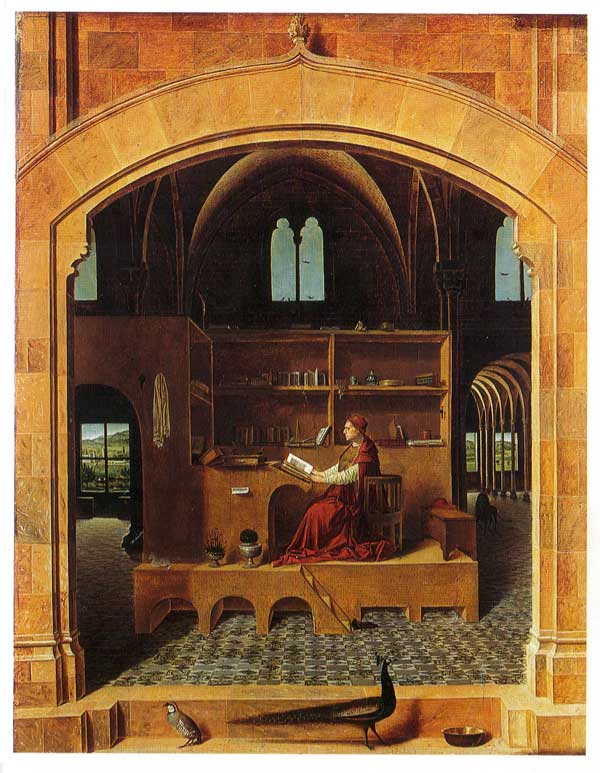 This is one of my favourite paintings, and it is one of a series of images that are the direct inspiration for a new project, which is the design and construction of a personal study carrol or 'writing closet'. All good design meets some need, and I have two convergent needs that can be addressed with the project. The first is the simple desire to design and build something I can occupy. The second is the need to create a psychological 'bubble' - a delicately balanced room or space that I can go into in order to think and write: a personal scriptorium, or perhaps "physical headspace".
This is one of my favourite paintings, and it is one of a series of images that are the direct inspiration for a new project, which is the design and construction of a personal study carrol or 'writing closet'. All good design meets some need, and I have two convergent needs that can be addressed with the project. The first is the simple desire to design and build something I can occupy. The second is the need to create a psychological 'bubble' - a delicately balanced room or space that I can go into in order to think and write: a personal scriptorium, or perhaps "physical headspace".Have a look at these paintings of St Jerome in his study: they each contain at least one idea that I will use to create my 'headspace'. In the frescoe below I see a pleasant homely clutter of writing and study implements including scissors, books and sheafs of paper. I am particularly interested in the overhead shelf.

The painting below shows the Saint in a more contained, closet-like carrol. It is not hard to imagine this 'study' as a box-like room of sorts, or at least an alcove. This painting is a delight, with the Saint's attendant lion stretching its paw up towards his hand. Again with the pleasing clutter of the man of letters.

This painting introduces a spatial relationship of particular interest: the study or carrol as a timber element you climb onto, in the corner of a larger room, positioned beneath a window. Again with the clutter.

The final painting elaborates the theme: platform of timber, corner of the room, positioned with a window integrated into the joinery. The Dutch style of side lighting is also important.
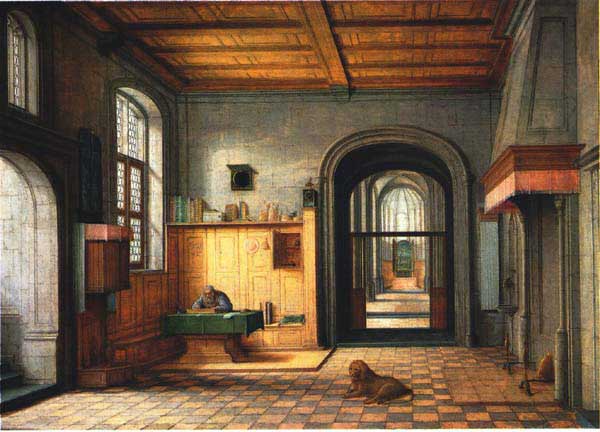
So that's the inspiration. Watch this space to see where I go with it. It is shaping up to be my most eccentric project to date: good times.
When seeing is doing
 The Laws of Attraction 1: Pantheon
The Laws of Attraction 1: Pantheon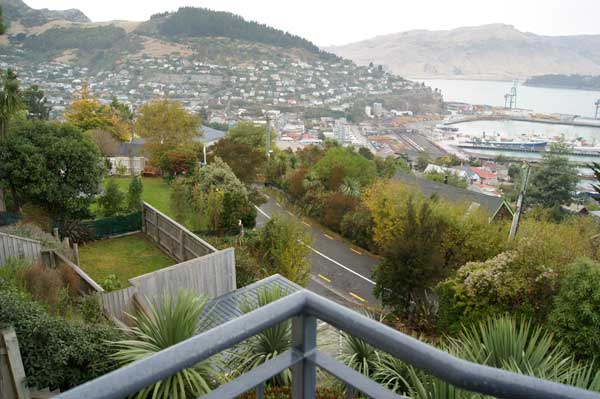 The Laws of Attraction 2: Lyttleton Harbour
The Laws of Attraction 2: Lyttleton HarbourI have been thinking about something that connects both of these images. In fact, I would go so far as to say that these two photographs are depictions of the same phenomena. This is a discussion about a personal experience, or perception: it may not be universal, but it is certainly shared.
One photograph is of Lyttleton Harbour in New Zealand, on the outskirts of Christchurch, as seen from the balcony of a small house. The other is of the Pantheon in Rome. More precisely, it is a photograph taken from the western side of the Pantheon looking over the crowds in the Piazza della Rotonda, who have been drawn to the building like metal filings to a magnet.
That's a clue to what I am talking about. The Pantheon generates a field of attraction - both as an idea, or a story, and as a building. People flock to see it, undoubtedly for a host of sensible reasons: it is so intact, and it is such a fine, direct and unequivocal public building. That might explain why people travel to see it.
It does not explain why the space of the Piazza is so charged, and that people feel compelled to just sit there in the building's presence. People drink coffee and beer, and consume pasta and pizza, in the presence of this building. Such things happen in other piazza(s), for sure - but there is a palpable sense of moment surrounding the Pantheon, similar to the atmosphere of anticipation in a theatre when the crowd is building and the house lights are still up. People sit in front of the building, doing something or nothing. The dependability of this behaviour is unquestionable, and the individual is part of the whole; something is happening.
Then there is Lyttleton Harbour. The working dock shown in the distance, there at the water's edge, exerted a familiar field of attraction on my recent visit. I felt that I could be perfectly satisfied just watching it as the light changed, and much like the cafés around the Pantheon, the houses on the hill are all oriented towards it.
Here's the thing: what is it about these two situations that is able to cut through the jaded, stuporous gaze of the contemporary viewer or tourist with such a potent charge? I am speaking of myself, of course. I am drowning in visual and other sensory stimulation, and yet both of these two situations exerted an influence over me that was almost mesmeric: a sense that to look was to be a part of something happening, that to be looking was to be doing.
What does this mean? I am not sure, but it is there, deep in my gut: the same thing is happening in both photos. I will write about this again, and perhaps speculate as to why architects and other designers expect the 'Pantheon effect' to hold true with every individual work, despite the fact that this obviously cannot be the case.
But if we don't aim to create a mesmerised, enraptured viewer for our design work, what do we aim for? I think it matters. Let me know what you think.
On aesthetic transgression
 Why would you not illustrate a jazz festival with a certain aesthetic? Why wouldn't you use a conservative 'American country club' serif font in gilt, with mahogany highlights, to illustrate a jazz festival? I don't mean an ironic aesthetic, but the real thing - uptight and frankly bad. Why wouldn't you do this, and what would happen if you did? I will come back to that last question.
Why would you not illustrate a jazz festival with a certain aesthetic? Why wouldn't you use a conservative 'American country club' serif font in gilt, with mahogany highlights, to illustrate a jazz festival? I don't mean an ironic aesthetic, but the real thing - uptight and frankly bad. Why wouldn't you do this, and what would happen if you did? I will come back to that last question.I am interested in the aesthetic 'force fields' connected to cultural forms, or for that matter any kind of activity...systems of aesthetic orthodoxy, at the edges of which we find the limits of acceptability and the point where the apparent aesthetic permissiveness of the genre or practice is shown to be anything but. The vigour with which such system are protected against 'corruption'.
We can look back in time and think of the Futurists or the first Bauhaus students as idealistic and in some way understand their zealous protection of an aesthetic objective. Somehow I understand, and I sympathise. More than this, I 'get it' visually - I instinctively know when something is 'not Bauhaus-like', even if such a thing is absolutely impossible to define, and I might in fact get it completely wrong. Still, I know that there is a syntax and a system, and that there are rules that extend well beyond the visual or aesthetic. These rules are social and cultural as much as they are aesthetic, in fact.
Which leads us back to this question: what happens if you transgress, if you move beyond the limits of acceptability for a given form or activity? Well, that's pretty straightforward. Ostracism: expulsion from the tribe.
Interesting.
Credit: Photo of poster by Francesco Basile
Take that, minimalism...
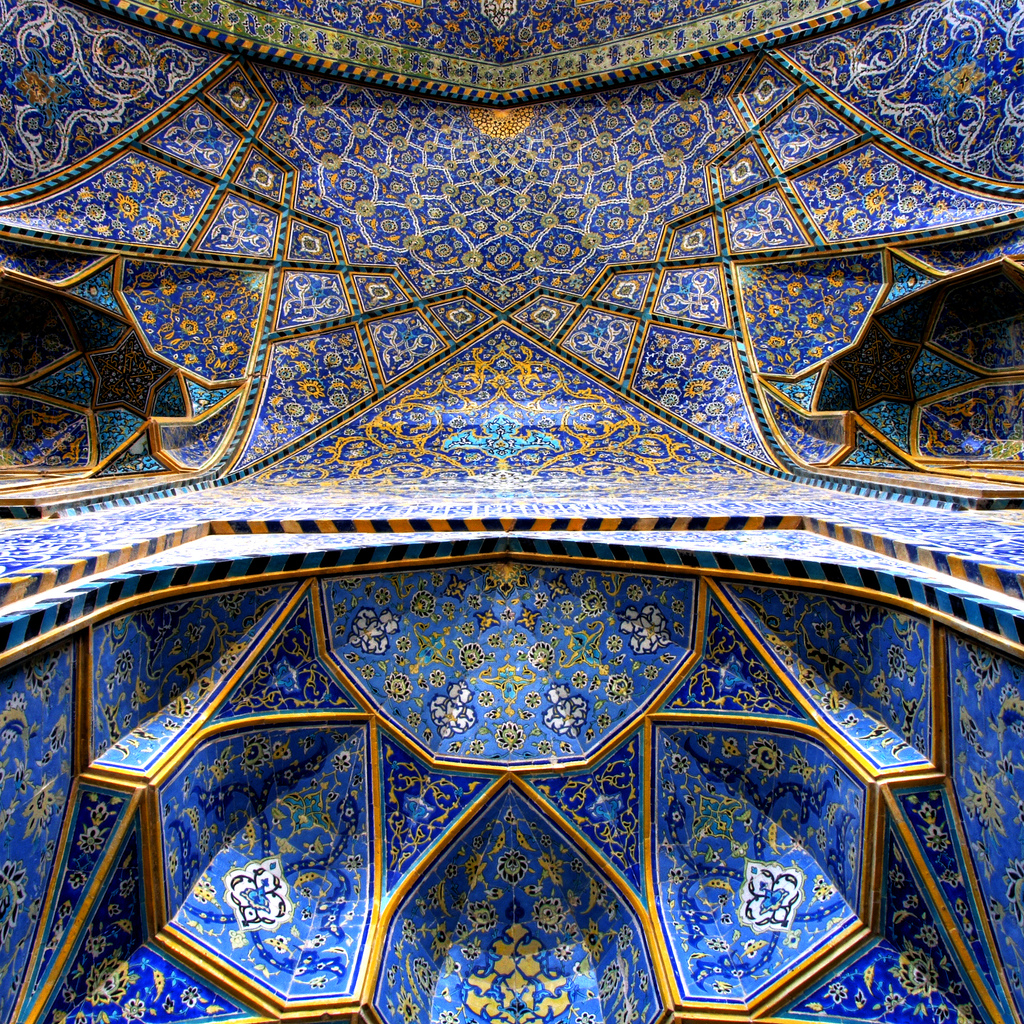 Detail of a half-dome in an Iranian mosque
Detail of a half-dome in an Iranian mosqueThis photograph of an Iranian building was posted by the blogger pesaretabrizi, who according to his website, is based in the UK.
Check out his full collection of images here.
Thinking by the Bay
 Dimmeys ladies on the beach at Sandringham, 1911
Dimmeys ladies on the beach at Sandringham, 1911Some things are hard to explain. In fact, some things are so difficult to explain that they rarely get explained in any but the most cursory, conversational setting. I was thinking about my freelance journalism gig the other day, and it occurred to me that to explain something that is subtle, nuanced and complex is much easier than explaining something ordinary or mundane. Nuance demands elaboration: the mundane does not. This can place the reader or listener in a situation where they may misunderstand an explanation simply because it is so surprising that the attempt to explain is being made in the first place.
Which is all a little abstract, so let me give you an example. On the weekend I was driving along the edge of Port Phillip Bay heading south from St Kilda. To the west the sun was setting over the Bay. To the east we skirted the edge of the popular beachside suburbs, zipping past a seemingly endless march of bloated, oversized and poorly styled houses facing out across the water, directly into the setting sun. Periodically we would pass an old hotel, an intrinsically fine building that had been renovated (but not restored) to within an inch of its life. It was these historic hotels, embalmed in acrylic paint and ugly signage, that first put me in mind of this difficulty of describing the mundane.
The work done on the hotels is almost unfailingly bad. This is immediately apparent to the trained observer. However, explaining why they are bad to a lay person is by no means an easy task. After all, they are ‘nice’ and in excellent condition, they have obviously had money spent on them, and they are undoubtedly genuine establishments - bona fide hotels, alcohol, bottle-shops and all - just as they were when they were first built. Nevertheless, there is something very wrong with nearly all of them, and it wouldn’t matter except that the buildings beneath the gloss are often conspicuously grand and fine, and in excellent locations.
Why bother trying to explain this to the lay person at all, you might ask? That is an interesting question. I do not subscribe to some tedious ideological position that sees information or knowledge as some Protestant ‘good’ to be foisted on people for their ‘own good’. The Australian Institute of Architects might beat the drum of ‘public education’, but I am not a sandwich board and really can’t be bothered, on the whole. However, explaining design-related things to non-designers, particularly intelligent ones, is an excellent discipline as it requires skill, clarity and precision to make the point. It also requires that you abandon your reliance on jargon - that strange verbal shorthand used (abused) by ‘communities of practice’ who share a common education, field or technique. Specialists, in other words.
Speaking about architects, amongst whom I spend most of my professional life, I have observed that in most cases jargon is not used to streamline communication so that the professional exchange can ascend to a higher level in a shorter time - as one might hope. Jargon is used by architects as a method of indefinitely suspending their disbelief in the face of claims and concepts that lack rigour, lack precision, remain untested and can be, frankly, unbelievable if rendered in plain speech. In other words, the waffling architect is prone to believing their own gobbledygook. However, in order to do so, he or she must continue to speak in tongues at all times, and never condescend to answer the simplest of questions, useful in almost all cases when an architect has just finished stating an idea with conviction: ‘what do you mean by that? ‘
The other use of the lay-person as recipient of an explanation is that it draws out the obvious. Things that are obvious to a designer usually are not obvious to non-designers, and to state the obvious is an excellent start to an explanation of complex matters. ‘Obvious’ is misplaced in this usage at any rate; what we really mean by ‘obvious’ is ‘assumed to be so on the basis of self-evidence’, with an educated specialist doing the 'assuming'. A funny thing happens when you state your assumptions: suddenly they don’t seem so ‘obvious’ after all. At least I assume this to be the case, as it is precisely what I experience when I state the obvious in the face of a design problem. Is this a shared experience?
In my design journalism I like to adopt the expectation of an intelligent, non-specialist reader as the gold standard. The main result of this approach is not merely a prohibition of jargon: it forces me to make a fundamental shift in my thinking. Ultimately it is a personal judgement, but I don't think that most intelligent non-specialist readers have much interest in the things that specialists focus on. As specialists we need to notice this, as despite our undeniably impressive bodies of knowledge, we continue to focus energy on things that have little or no resonance with the lay person. The perceived 'ugliness' and 'unfriendly' aspect of many architect-designed buildings is one such area. Architects do not discuss this, and the unspoken assumption seems to be that if 'they' were better educated, and had cultivated 'their' taste above the common denominator, then 'they' would 'get it'.
Is that so. I have long suspected that architects of the third millennium avoid decoration, complicated, florid detail and legible rooflines so much - because they do avoid them - because they involve risk, and a visual composition that incorporates complexity is so much harder to control than monolithic, minimalist simplicity. Both are equally hard to do well, but only one of the two is easy to do inoffensively well.
I wonder what the ladies of Dimmeys, the venerable Melbourne department store, shown here on the beach at Sandringham in 1911, would have thought of the post-millennial renovations of the nearby hotels? How would they have seen the stripping out of detail, the dismantling of the complicated rooflines, the removal of polychrome colour schemes in favour of monolithic blocks of colour, and the obsessive sealing of the verandahs with impenetrable sheets of glass, all in the interests of replicating the bland, air-conditioned uniformity of the rooms within? Isn't the whole point of a verandah to be taking the outside air, and yet with some of the comforts of a room - a good chair, a side table for your Pimms and lemonade? Apparently this is no longer the case.
Many architects reading this should probably disregard what I say, although they certainly won't wait for my permission or encouragement to do so. If not they might find themselves designing buildings that their grandmothers could relate to - and that, surely, would signify that the taste war has finally been lost.
Wouldn't it?
Not Serious Design
 I’ve been thinking about design and design journals. In the interests of full disclosure, allow me to first say that I regularly write for the Australian design magazine Artichoke, which is the Journal of the Design Institute of Australia. Fortunately for the members of the Design Institute and I, Artichoke routinely avoids falling into the category of journal that I discuss in this post. I like writing for Artichoke because my colleagues on the editorial staff seem happiest when I am speculating about what design might be, as understood through various projects, and not merely what it is. I try to regard the design process as exactly that, an interesting process that has had results, and not a closed or stable system that periodically gives birth to polished gems.
I’ve been thinking about design and design journals. In the interests of full disclosure, allow me to first say that I regularly write for the Australian design magazine Artichoke, which is the Journal of the Design Institute of Australia. Fortunately for the members of the Design Institute and I, Artichoke routinely avoids falling into the category of journal that I discuss in this post. I like writing for Artichoke because my colleagues on the editorial staff seem happiest when I am speculating about what design might be, as understood through various projects, and not merely what it is. I try to regard the design process as exactly that, an interesting process that has had results, and not a closed or stable system that periodically gives birth to polished gems.It is a subtle distinction, perhaps, but I am old-fashioned enough to believe that good journalism should expose and explore subtle distinctions. ‘What might design be?’ is a question. Describing and sharing what design is has value in encouraging people to discover new wrinkles of this fascinating pursuit, but it is not a question: it is the provision of an answer. I boldly suggest that questions are far more interesting than answers.
It seems to me that if we approach this particular question with an open mind then the situation is very different to that closed, rather self-congratulatory impression you get from many design journals. This impression is painfully apparent to the uninitiated, who in my experience are more likely to be respectfully intimidated than skeptical and disdainful, as perhaps they should be.
Reading much of the design press, you can also get the impression that the producers have forgotten that ‘cool’ and ‘good’ are not the same thing. ‘Cool’ and ‘good’ are not the same thing. If the overwhelming impression an intelligent non-designer gains from a magazine is 'hey, isn't this cool, and aren't we cool, you and I, for knowing it', then something is amiss. The moment's best furniture, clothes, objects, bars and restaurants - most design-related organs are more of a latter day 'gentleman's outfitters' updated so that the bloodless, androgynous urban dandy, he or she, has all they need for an aesthetically better life. A better German bike courier's messenger bag, better Spanish shoes, better Japanese stationery: artfully generic and label-free, or crafted from industrial discards and finished with fine details? Take your pick.
This might offer all the high-calorie comfort and entertainment of shopping, but those non-mail-order catalogues (can you tell me the trade price on the B&B Italia sofa on page 85?) rarely stoop to posing uncomfortable questions, or airing awkward truths. The first among these must surely be the relationship between wealth and design. It's not good, it's not bad, and it's not discussed.
The 'Andy' sofa, 370 cm long, 3-seat with a chaise lounge upholstered in a mid-range fabric, costs $AUD27,325.00. That is $US25,374 by today's exchange rate. What does it mean to spend more than $25,000 on a sofa? Is there any way that can be a reasonable thing to do? The Federal minimum wage decision for 2009 in Australia is an income of $AUD543.78 per week. So the sofa is worth just over 50 weeks of the minimum wage, virtually a year of person hours. You may think I am mounting some socialist argument about the distribution of wealth by pointing this out; I confess to such a bias, but that is not really my point. My point is one of perspective and relativity, and the conditions that provide insight to the designer. By pushing design into such stratospheric heights, we disconnect our focus as designers from the experience of the vast majority of people in our society. Is that ok?
Certainly, in order to do so, we must avoid uncomfortable questions about wealth and privilege, and the bearing these things might have on aesthetics. However, I am less interested in the moral implications of that than in the fact that we are excising from the ‘world’ of design much of those things which quite simply make up the world. Worse crime still: it’s boring. Boring to avoid straying from the ‘best of the best’, to censor what constitutes ‘serious’ design.
Forget about the morality of it for a moment, this isn’t just about morals or even ethics. What are you buying when you spend so much? An argument can be made that quality takes time and costs money, and that a brilliantly crafted designer piece will last far longer, and perform better, than the cheaper alternative. That is almost certainly true, and I also wouldn’t like to see the working designer unable to reap the rewards of their creativity, knowledge and training.
But again, it is a question or relativity. Let’s be honest here, there has to be a point where this argument fails to hold water, and become mere cover for privileged indulgence. Where does the line fall? Three times the cost of a functional alternative? Ten? Twenty? Someone tell me: is a bona fide B&B Italia sofa worth 50 weeks of the minimum wage? Am I the only one who thinks this is all a bit distorted?
I have in my apartment a very awkward object. It certainly does not constitute, and would not ever be considered, ‘serious’ design. I suggest that it hasn’t been designed at all, at least not in the conventional sense. It is a timber easel, hand-carved, standing six feet high. What I like about this easel, on loan from a friend who couldn't bear its lack of Scandinavian minimalism, is that it would never appear in a design journal. Never. It doesn't even manage kitsch, although it might manage to figure in a social realist photograph, perhaps one taken in Kentucky or Miami.
This makes it a fascinating object to me, and while I won’t defend its aesthetic qualities (should I have to?) I will say that I like having it around. The reasons for this have a lot to do with what it evokes for me, and the pleasure I get from the design-canon-violating aesthetics of hand-carved timber. The thing even has flowers carved into it, and part of it appears to be shaped like a pair of spectacles, or breasts. (The easel pictured here is not the actual one, but you get the idea.)
Does this damage my credentials as a ‘serious’ designer? Probably. What a relief that is.
Atmosphere and image
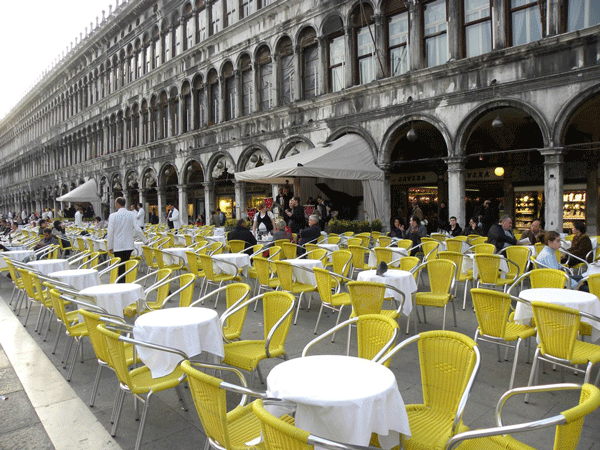
I am looking at a photograph that I took in Piazza San Marco in Venice in November. You can see it above, with its cheerful yellow chairs clustered around tables set with crisp linen cloths. I am looking at the image in a large digital format, much larger than shown on this website, and by concentrating on the details I am taken back into the moment. The moment was shared with a friend who had accompanied me on a walking tour of the City that day, and I can vividly remember the sense of the place, the temperature and humidity of the air, the flat whiteness of the sky and a thousand other details that are not experienced as such, but woven together to create a unique 'atmosphere'.
Images can be transporting in this way, taking us to far-off places, but to overstate their power to do this is romantic at best and misleading at worst. More often than not the power of the image is heavily diluted and diminished, and I attribute this to two things - the saturation of our visual environment, and the overstatement of the power of imagery alone in the absence of other sensory cues.
Marking this fact is seen as a bit superfluous, and generally the creative professions just get on with the business of image production and manipulation. Nevertheless there is something in it, something about the notion of the image as a single weapon in a broader arsenal that is not often discussed.
I am always mildly anxious while taking photographs. This is not an emotion inspired by a fear of making a poor image, something I avoid most of the time and can tolerate passably well when it does occur. It is a different kind of anxiety, an awareness of the moment being enshrined and frozen, almost as if I am scared of what might be captured by the lens. I tend to frame the shot with something of an aesthetic sense, but quickly, and not dwell on details that are plainly visible to me at the time, by virtue of my being there. I tend to quickly frame and fire off the shot, and just wait to see what it yields later on, rather than spending a moment pondering what I am seeing and considering how it could be framed.
When this goes well there is a spontaneity to the imagery, but when it does not go well the shots are poorly framed, or I see later that an opportunity was there but overlooked. The issue of making good or poor imagery is not really the point I am interested in, as I feel that closer attention to the technique of observation and framing helps this immensely. I am far more interested in the experience of marking a moment in time by capturing its specifics, and the relationship of this to the atmosphere of the place.
'Atmosphere' is not something that serious architects or designers discuss very often. It is seen as a non-professional or amateurish word, more suited to the realm of the decorator or Friday-night home improvement television programme. I disagree, and think that it is a fine word, and very useful for encompassing a broader spectrum of personal experience linked to place than the more restrictive 'style' or 'language'. What I really like about the word 'atmosphere' is that it is rooted in the experience of the person in the place, whereas more 'serious' technical architectural terminology is almost always focused on the characteristics of the space, building or place being experienced.
This is not a subtle distinction. To use the example at hand, Piazza San Marco has architectural and spatial characteristics, but to consider it as being merely the sum of those characteristics is to deny the richness of the actual experience of the place. The Piazza is never experienced independent of the temperature, the humidity, the quality of light, sounds, odours, movement and the presence of other people and the different things they are doing. In fact there is a wealth of nuance and subtlety - and an abundance - to the atmosphere of the place, and it is constantly changing. it is there to experience, if we can only tune our awareness to soak up the atmosphere in all of its parts.
Architectural discourse - the way architects speak to each other - is heavily censored and restricted, and this affects how we think about what we do, and how we discuss it with outsiders. It is partly the choice of words, driven by a sense of what is professionally orthodox and appropariate, and what is amateurish and 'beneath' a trained professional. Outsiders should not underestimate the designer's fear of being seen as 'uncool', either - I'm quite serious about that. Designer Bruce Mau acknowledges the corrosive power of 'coolness' in his studio's excellent Incomplete Manifesto where it is put like this:
14. Don’t be cool.
Cool is conservative fear dressed in black. Free yourself from limits of this sort.
Visiting Piazza San Marco is undeniably a cool thing to do so perhaps my example is a poor one, but nevertheless, an 'uncool analysis' of what this photograph taps into points to something quite outside an orthodox architectural discourse. If the photograph transports me to another time and place, it is not because I have captured the 'essence' of the place in my image: it is because there is enough detail in the image to evoke my memory of being there, reminding me that I was footsore, cool but not cold, suffering from the glare of an overcast day and overwhelmed by the simple wide-eyed fact of being there for the first time. All of those things forged the atmosphere of the place as a personal sensory and visual framework: from that comes the emotive and evocative charge of the image.
This quality of 'atmosphere' exists everywhere, and not just in photogenic tourist destinations: how it accumulates over time and with the familiarity of the everyday is of particular interest to me. The density of experience it amounts to is so common that we are usually blind to it, and we become insensitive to the places we go every day. Nevertheless, the subconscious or unconscious mind is always assimilating detail, and over time we build up a rich, dense and nuanced composite picture of the places we know. If you doubt this, think now of a place you knew and liked - or disliked - in childhood: the formative memories can be the most potent.
Designers use images to create. We use photographs and drawings to capture what exists, and to visualise and make real what does not yet exist. If we as designers can somehow more closely link the intention of the image to a sense of a place's atmosphere, we may find ways to describe an emotional and atmospheric reality embedded in what exists, and yet evocative of what we wish to create. This might be fertile new ground.
The failure of design

I've been thinking about what constitutes good design, and find that it is a difficult question to answer.
Design would appear to be the new mantra, in business and in the 'lifestyle industries', to use a ghastly phrase. 'Good' or 'serious' design is assumed to always add value, and it is assumed by designers, and increasingly the educated general public, to be always highly desirable to it's alternative. However, what this alternative might be is by no means clear, and in that I detect something interesting.
Designers will tell you that the opposite to 'good' design is 'bad' design, where something has been shaped or put together in a way that responds poorly to its intended purpose and meaning. That seems reasonable, but I am not sure it holds up to scrutiny. What if the opposite to 'good' design is something far more incidental? Could the opposite of 'good' be not so much bad as 'whatever' - a genuine randomness that results from the inevitability of form in objects despite the absence of authorised, orthodox design intentions? Good design can be judged against a whole host of factors which might include the intention as stated, the function as demonstrated in use, or the aesthetics and shape. How would we judge 'bad' design? For that matter, why do we feel compelled and authorised to judge it?
They Mythical Modernist has a ready answer to this. The MM might argue that when it comes to things made by people, 'all is design, and all is designed', whether we like the results or not. If this is true then it is reasonable to judge all objects and forms by the same standard, and if we do that it stands to reason that we as 'good designers' would decry the poor standards of the design of most objects and buildings we encounter.
There are a couple of problems with this. This claim of the omnipresence (or omnipotence?) of 'design' is a kind of megalomania that has everything in common with the modernist definition of urban design as the imparting of 'right form' to whole neighbourhoods and cities. Then there is the problem of applying the 'same standard' to good and bad, or unintentional design. How is this standard determined?
The standard of 'right form', also known as 'serious design', is determined by common agreement - leading example and its enthusiastic approval - and codified into a visual syntax or codex policed by the high priests (the 'leading' designers), whomever they might be. This forms a kind of gold standard against which most things can be measured, and in the measuring some things are deemed as 'good' and some as 'bad'.
One problem with the gold standard of 'good design' is that it inevitably changes over time. Nevertheless at any given time it is considered immutable, a yardstick against which we can separate 'serious pieces of design' from their poor cousins. Any architect would admit that a 'really good building' of thirty - or even ten - years ago would look dated and be considered inappropriate now. Strangely, this is not seen as a flaw in the method of determining good design: it would seem that the codex has a convenient 'out' clause, where older projects can be authorised by virtue of their dated context.
Despite some very obvious structural cracks, it is plain to me that some designers, architects in particular, believe that the 'good design' standard has some gravity and authority. They firmly believe (or perhaps assume) that the world overall would be a substantially better place if only it was designed by them and their colleagues. There is not much evidence to support this view. The most beautiful and engaging places I have seen ended up that way largely without architects, with the possible exception of key buildings of particular significance. In fact the profession as it is currently defined is very young, and many buildings we attribute to architects were actually conceived and designed by dilettantes and artists. Architects and other designers also seem to overlook the megalomania of this idea: should our entire environment really be wholly determined by one tiny and not particularly representative segment of our society? Does that even look right as an idea on paper? I think not.
Despite the fact that we are bound in by ugliness on all sides, I don't think that giving the whole equation to the architects is the answer. I can only think of a handful who do work I like, for a start. Fortunately for us the world is a diverse and complex place, and so far orthodox design has failed to encompass all of human life. That's a good thing, because I suspect that the seeds of our future world - the lightning bolts of brilliance and breathtaking change - will not first be seen on the pages of a glossy design magazine.
